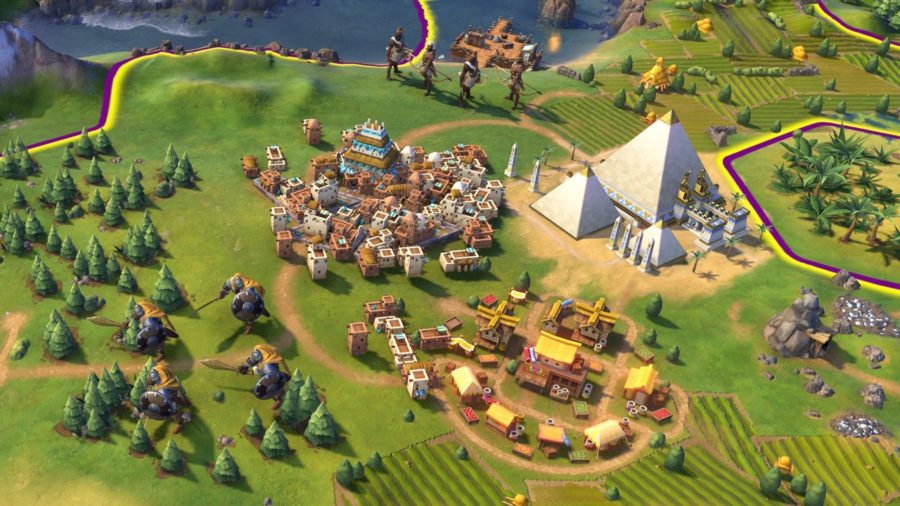Sid Meier’s “Civilization” was one of the first real strategy games in modern gaming. The franchise still has fans, and the subsequent series has come a long way since the first installment, released in 1991.
“Civilization VI” is a turn-based strategy game in the style of resource-based board games, which revolves around the evolution of human culture. Progressing from simple cavemen with huts and stone tools to modern cities with skylines and nuclear bombs, you take control of one of 18 civilizations, or “civs,” each with a leader you interact with.
The main goal of the game is to help your civilization reach one of five different win states, with science, domination, culture and religion scores replacing the diplomacy victory points from past games if none of the other victory conditions are met.
So how does “Civilization VI” compare to “Civilization V” and the rest of the series?
When “Civ V” was first released it was a mess. The “hot seat” multiplayer function had to be patched in, as did the ability to save a multiplayer game. Mid-game got dull fast, and without expansion packs or modifications it was tough to get to the later content running the basic game alone. It’s not odd for a “Civ” game to be incomplete at launch, and while this is usually a mark against a game, in this day and age it’s often expected for the game to be chopped up into bits and offered as downloadable content, or “DLC.”
But “Civ VI” is playable from the start. Everything from the last game is there: city-states players can befriend and get bonuses from religion, which gives bonuses to the founder of said religion, and trade systems where players must earn gold coins by making trade with other civilizations, but you can now better aid growing cities.
The graphics are very cartoony and stylized compared to the more realistic style of “Civ V.” The leaders are all animated with very over-the-top mannerisms attributed to the historical figures, and speak their native languages.
The roster of leaders changes from one installment of the series to the next, but to see almost all new leaders in “Civ VI” is a pleasant surprise. Now we get leaders like Roosevelt instead of Washington for the United States and Catherine de Medici for France instead of Napoleon. The developers wanted to display each civilization’s most charismatic leader, except for Germany’s Hitler and Russia’s Stalin for obvious reasons.
The only problem I have with the leaders is the new two-agenda system. Each AI controlled leader has a different agenda tied to them reflecting what they were known for when they ruled in real life; Gandhi never declares war on people, Pedro the Magnificent attracts as many great people to his empire as possible, and Roosevelt tries to keep his and any civ on his continent safe with a large army. This becomes interesting when you add a second agenda to each leader. With the randomly assigned agendas, you can have an environmentalist Roosevelt or a nuke-happy Ghandi. Frederick’s first agenda is he does not like city-states; with a second agenda to like and guard city-states you’ll get bombarded with messages from him both damning and praising you for working with city-states.
In “Civilization V” there was a United Nations that met every couple of turns where you could make changes to how players run their civs, like taxing standing armies or banning nuclear weapons. In “Civilization VI” the U.N. is gone, replaced with a peace-time warfare. You make missionary units to fight opponents’ missionaries for conversion of their cities to your faith. You don’t have to declare war to do so as missionaries can go anywhere, but if you haven’t founded a religion or your missionary army isn’t strong, there is war, but that’s different too.
War has always been an interesting and evolving part of “Civilization,” as it reflects how real-life wars have evolved and changed over the years. War is as damaging to your civ as ever and combat can be won by strategy or brute force. But you can no longer freely build roads, and workers, who help improve tiles of the game board, are discarded after three uses. This makes moving your army across land a lot slower than in previous editions of the game. To make up for this everyone now has to have a standing army, as barbarian raiders are a real threat. Workers are needed to repair battle-damaged tiles, which slows down production. It also affects city growth, as your workers need housing.
Another change is that happiness is measured per city, rather than for your empire overall. Replacing luxuries and happiness-generating buildings destroyed in war takes a while, so war has a major impact on your civ. Also the warmonger penalty is stronger now and increases through the ages as your population begins to view war as a bad thing. However, with casus belli, or “justified war,” you can reduce your warmonger penalties.
In past games a city is just the center tile of its area of influence. Now you have to build districts to get the same effect. You can specialize your cities with a given task. For a trade centered city, a harbor and commercial hub will make it rain gold. If your empire is low on faith and culture, have a theater and a holy site to make it the culture center of your empire. Specializing comes at a cost, though. When you place a district on your board it destroys anything that was already on that tile. And if it gets damaged you have to spend production on repairing it.
Overall, “Civilization VI” is a great strategy game, and now you don’t have to wait a year or two for all the expansions to come out.




